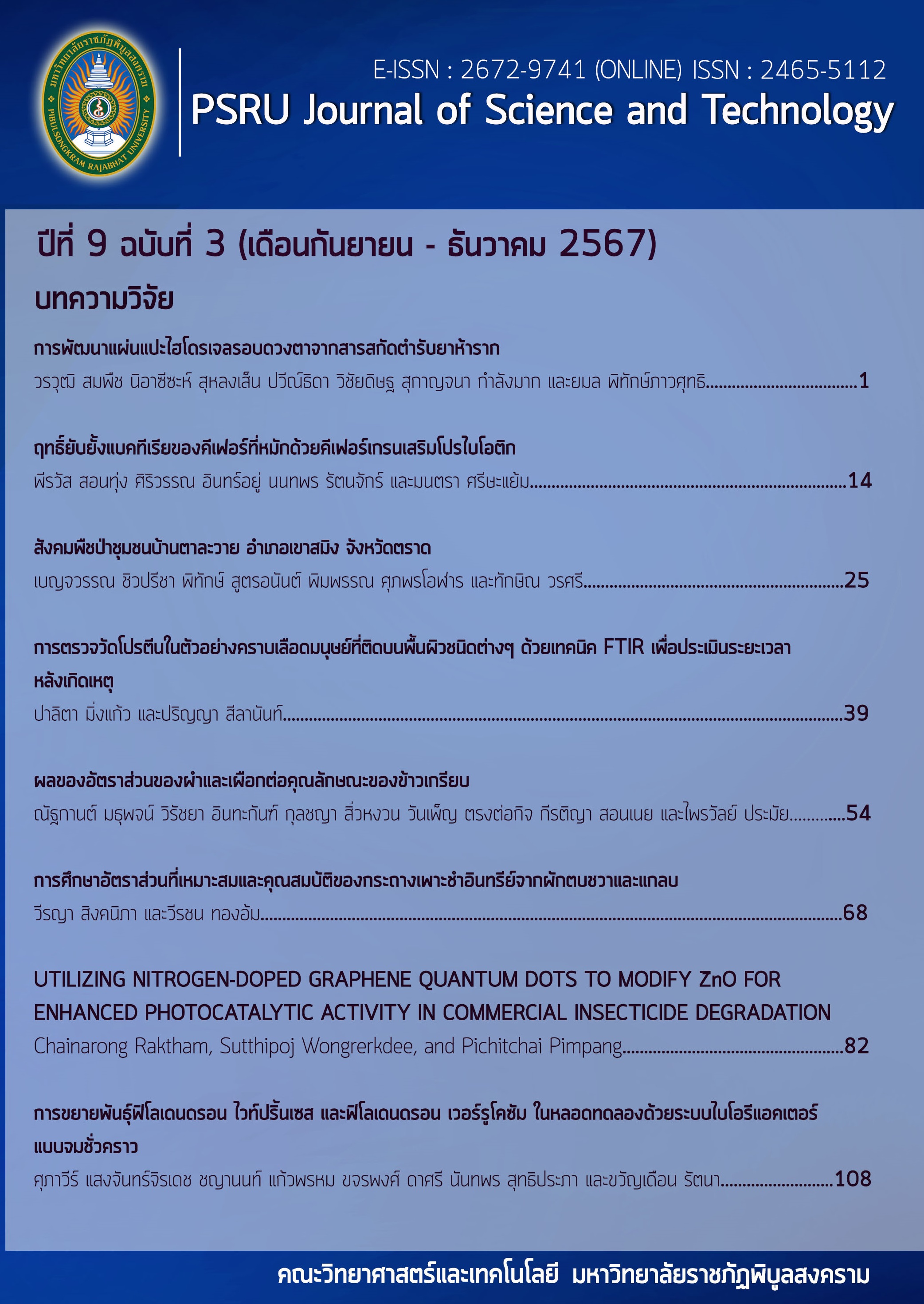THE STUDY OF THE APPROPRIATE RATIO AND PROPERTIES OF ORGANIC NURSERY POTS FROM WATER HYACINTH AND RICE HUSKS
Keywords:
Organic nursery pots, Water hyacinth, Raw rice husks, Primary macronutrientsAbstract
This research aimed to study the appropriate ratio for forming organic nursery pots from water hyacinth and raw rice husks, the macronutrients in raw materials, and the macronutrient content in organic nursery pots. The strength and water-holding capacity of the obtained organic nursery pots were investigated. Subsequently, these were used to grow the tomatoes. The results indicate the nitrogen, phosphorus and potassium content in the range of 3.425-5.013%, 0.015-0.028% and 0.808-2.213%, respectively. The strength and water absorption tests are varied from 15.467x103-49.467x103 N/m2, and from 25.496-43.531%, respectively. However, the tomato growing in the organic nursery pots with the third formula i.e., the ratio of water hyacinth to raw rice husk to paste glue is 80 : 20 : 300, exhibits the highest average number of leaves and height. Therefore, in this research, an alternative is to use materials that are environmental problems and agricultural by-products to make organic nursery pots. In addition, the organic nursery pots developed are pots that increase the amount of nutrients for the seedlings, providing an environmentally friendly solution.
References
กรมวิชาการเกษตร. (2548). ปุ๋ยอินทรีย์การผลิต การใช้ มาตรฐานและคุณภาพ. (พิมพ์ครั้งที่ 17). กรุงเทพฯ: กรมวิชาการเกษตร.
กิตติชัย โสพันนา, วิชชุดา ภาโสม, นกวรรณ วรดง, และอนันตสิทธิ์ ไชยวังราช. (2558). การประดิษฐ์และสมบัติของกระถางชีวภาพ. SNRU Journal of Science and Technology, 7(2), 1-7.
เกตุสุดา พรมพินิจ, จุฑารัตน์ รอดพ่วง, และสหรัฐ จันจาเร. (2564). การพัฒนาภาชนะเพาะชำจากเศษชีวมวลสำหรับพืชเก็บเกี่ยวราก. (ปริญญาวิทยาศาสตรบัณฑิต). มหาวิทยาลัยเทคโนโลยีราชมงคลพระนคร, คณะวิทยาศาสตร์และเทคโนโลยี, สาขาวิทยาศาสตร์และเทคโนโลยีสิ่งแวดล้อม.
จักรพงษ์ กางโสภา, และบุญมี ศิริ. (2562). การเปลี่ยนแปลงความงอก ความแข็งแรง และการเจริญเติบโตของต้นกล้าผักกาดหอม (Lactuca sativa L. ) หลังการพอกเมล็ดพันธุ์ร่วมกับฟอสฟอรัส. วารสารเกษตรพระจอมเกล้า, 37(2), 274-283.
ชัยวัช โซวเจริญสุข. (2565). แนวโน้มธุรกิจ/อุตสาหกรรม ปี 2565-2567: อุตสาหกรรมข้าว. สืบค้นเมื่อ 1 สิงหาคม 2566, จาก https://www.krungsri.com/getmedia/305ada9b-d04a-43ab-808e-332becf8c14a/IO_Rice_220203_TH_EX.pdf.aspx
นัยนันทน์ อริยกานนท์. (2561). ผักตบชวากับการบำบัดสารมลพิษในน้ำ. วารสารสิ่งแวดล้อม, 22(3), 51.
ประไพพรรณ จันทร์ทิพย์. (2559). การทำปุ๋ยหมักผักตบชวาร่วมกับกากตะกอนส่วนเกินจากระบบบำบัดน้ำเสียของโรงงานน้ำยางข้น และกากตะกอนจากโรงงานยางแท่ง STR 20. (วิทยานิพนธ์ปริญญามหาบัณฑิต). มหาวิทยาลัยสงขานครินทร์, บัณฑิตวิทยาลัย, สาขาวิชาการจัดการสิ่งแวดล้อม.
สุทธวรรณ สุพรรณ, ประดับรัฐ ประจันเขตต์, และสิริแข พงษ์สวัสดิ์. (2559). การใช้แบคทีเรียตรึงไนโตรเจนร่วมกับวัสดุตัวกลางชีวภาพเพื่อการส่งเสริมการเจริญของพืช. Progress in Applied Science and Technology, 6(2), 17-28.
สุรชัย สังข์งาม, และวิโรจน์ เชาว์วิเศษ. (2566). กระถางเพาะกล้าไม้ที่เป็นมิตรต่อสิ่งแวดล้อมจากกากตะกอน น้ำมันปาล์มและผักตบชวา. Journal of Advanced Development in Engineering and Science, 13(38), 96-107.
อรรถพล เปลื้องไธสง, ธรรมเรศ เชื้อสาวถี, และวิทยา ตรีโลเกศ. (2566). การศึกษาอัตราส่วนของแกลบที่ผสมกับปุ๋ยหมักเปลือกมันสำปะหลังต่อสมบัติดินในพื้นที่ดินเค็ม จังหวัดบุรีรัมย์. Khon Kaen Agriculture Journal, 51(1), 162-171.
Bansal, O.P., & Singh, A. (2022). A review on microplastic in the soils and their Impact on soil microbes, crops and humans. International Journal of Research - GRANTHAALAYAH, 10(9), 245–273.
Iwuagwu, M.O., Ogbonnaya, C.I., & Onwuchekwa, O. (2020). Complementary effects of rice husk and nitrogen fertilizer on the growth, yield and nutrient uptake of cocoyam (Colocasia esculenta (L.)). Schott American Journal of Plant Biology, 4, 1-11.
Nilawonk, W. (2012). Effects of vermicompost on plant-available nitrogen content in organic cropping soils in Chiang Mai, Thailand. In 5th Annual International Symposium on Agriculture. 16-19 July 2012, Athens: Greece.
Rommens, W., Maes, J., Dekeza, N., Inghelbrecht, P., Nhiwatiwa, T., Holsters, E., Ollevier, F., Marshall, B., & Brendonck, L. (2003). The impact of water hyacinth (Eichhornia crassipes) in a eutrophic subtropical impoundment (Lake Chivero, Zimbabwe) Water quality. Archiv für Hydrobiologie, 158(3), 389-405.
Sarangi, M., Bhattacharyya, S., & Behera, R.C. (2009). Effect of temperature on morphology and phase transformations of nanocrystalline silica obtained from rice husk. Phase transitions, 82(5), 377-386.
Schettini, E., Santagata, G., Malinconico, M., Immirzi, B., Mugnozza, S., & Vox, G. (2013). Recycled wastes of tomato and hemp fibers for biodegradable pots: Physico-chemical characterization and field performance. Resour Conserv Recycl, 70(3), 9-19.
Senathirajah, K., Attwood, S., Bhagwat, G., Carbery, M., Wilson, S., & Palanisami, T. (2021). Estimation of the mass of microplastics ingested–A pivotal first step towards human health risk assessment. Journal of Hazardous Materials, 404, 124004.
Srisunont, T., Wongsakoonkan, W., Tongphanpharn, N., Ratanasongtham, P., & Srisunont, C. (2024). A brief overview of biodegradable pots for sustainable environment in Thailand. Curr. Appl. Sci. Technol, 24(5), 1-13.
Sullivan, D.M., & Andrews, N.D. (2012). Estimating plant-available nitrogen release from cover crops. U.S.A.: A Pacific Northwest Extension Publication, Oregon State University.
Thomas, B.T., Olanrewaju-Kehinde, D.S.K., Popoola, O.D., & James, E.S. (2015). Degradation of plastic and polythene materials by some selected microorganisms isolated from soil. World Applied Sciences Journal, 33(12), 1888-1891.
Yu, H., Fan P., Hou J., Dang Q., Cui D., Xi B., & Tan W. (2020). Inhibitory effect of microplastics on soil extracellular enzymatic activities by changing soil properties and direct adsorption: An investigation at the aggregate-fraction level. Environmental Pollution, 267, 115544.
Downloads
Published
How to Cite
Issue
Section
License
Copyright (c) 2024 PSRU Journal of Science and Technology

This work is licensed under a Creative Commons Attribution-NonCommercial-NoDerivatives 4.0 International License.
กองบรรณาธิการขอสงวนสิทธิ์ในการปรับปรุงแก้ไขตัวอักษรและคำสะกดต่างๆ ที่ไม่ถูกต้อง และต้นฉบับที่ได้รับการตีพิมพ์ในวารสาร PSRU Journal of Science and Technology ถือเป็นกรรมสิทธิ์ของคณะวิทยาศาสตร์และเทคโนโลยี มหาวิทยาลัยราชภัฏพิบูลสงคราม และ
ผลการพิจารณาคัดเลือกบทความตีพิมพ์ในวารสารให้ถือมติของกองบรรณาธิการเป็นที่สิ้นสุด







